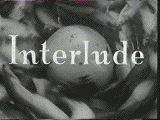 Up to 1964 there were only two television channels in the UK: BBC and ITV, though if you lived on the boundary of two ITV areas it was possible to receive more than one ITV service, but the majority of the programmes would essentially be the same. BBC2, it was hoped, would offer more than just ‘more of the same’ and would have an entirely different ‘character’ to the other two established networks. BBC2 would also be different in that it was transmitted using 625 lines on UHF channels which matched the post-war standard ratified by convention and used in continental Europe as opposed to the existing 405 line pre-war UK system, though colour was still a few years away and its introduction was delayed by the move to 625 lines.
Up to 1964 there were only two television channels in the UK: BBC and ITV, though if you lived on the boundary of two ITV areas it was possible to receive more than one ITV service, but the majority of the programmes would essentially be the same. BBC2, it was hoped, would offer more than just ‘more of the same’ and would have an entirely different ‘character’ to the other two established networks. BBC2 would also be different in that it was transmitted using 625 lines on UHF channels which matched the post-war standard ratified by convention and used in continental Europe as opposed to the existing 405 line pre-war UK system, though colour was still a few years away and its introduction was delayed by the move to 625 lines.
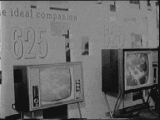 From the start, BBC2 faced an uphill struggle. Because of the different line and frequency standards used for BBC2, a new television was required along with an additional aerial in order to receive the new service. The early sets that could receive BBC2 were known as dual standard receivers because they had to cater for BBC1 and ITV on 405 lines VHF as well; it would be a few years (dependent on the area) for BBC1 and ITV to also be made available on UHF, with the last area to switch to UHF being the Channel Islands in 1976. A few 405 line VHF sets were capable of being upgraded to 625 line UHF operation.
From the start, BBC2 faced an uphill struggle. Because of the different line and frequency standards used for BBC2, a new television was required along with an additional aerial in order to receive the new service. The early sets that could receive BBC2 were known as dual standard receivers because they had to cater for BBC1 and ITV on 405 lines VHF as well; it would be a few years (dependent on the area) for BBC1 and ITV to also be made available on UHF, with the last area to switch to UHF being the Channel Islands in 1976. A few 405 line VHF sets were capable of being upgraded to 625 line UHF operation.
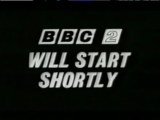 BBC2’s opening night was a total disaster; it was hit by a major power failure, though the fireworks which featured the two kangaroos (the baby one jumping out of its mother’s pouch) still managed to shine on the opening night. These kangaroo mascots (Hullaballoo and Custard) were initially used to publicise the new service, with the basic concept being that BBC2 was the new ‘child’ of BBC-tv (which was soon to be known as BBC1 – though because BBC2 was only viewable in London and the Midlands to begin with, the idea was slow to catch on).
BBC2’s opening night was a total disaster; it was hit by a major power failure, though the fireworks which featured the two kangaroos (the baby one jumping out of its mother’s pouch) still managed to shine on the opening night. These kangaroo mascots (Hullaballoo and Custard) were initially used to publicise the new service, with the basic concept being that BBC2 was the new ‘child’ of BBC-tv (which was soon to be known as BBC1 – though because BBC2 was only viewable in London and the Midlands to begin with, the idea was slow to catch on).
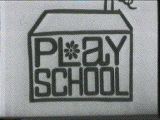 The previous day’s blackout meant that the first programme to be transmitted in its entirety was Play School the following morning, though the channel then closed down until the early evening. Play School became a very popular series for pre-school children and was produced right up until 1988 when it was replaced by Playdays, and elements of Play School were also used in Tikkabilla.
The previous day’s blackout meant that the first programme to be transmitted in its entirety was Play School the following morning, though the channel then closed down until the early evening. Play School became a very popular series for pre-school children and was produced right up until 1988 when it was replaced by Playdays, and elements of Play School were also used in Tikkabilla.
 This picture was taken from the ‘proper’ start of the first early evening programmes, with the candle being symbolic of the previous evening’s power failure. Also because not everybody could receive the new service, most BBC2 programmes had to be repeated later on BBC1 after their first showing. Each evening initially started with a 10 minute programme presented by Denis Twohy (pictured), entitled Line-up which gave a preview of the evening’s programmes on the channel. In other words, Line-Up was just an extended promotion for the channel, which is how viewers and critics treated it therefore Line-Up was replaced in September by Late Night Line-Up, an open-ended discussion programme shown at the end of an evening just before closedown so as not to constrain its end time, which also introduced Joan Bakewell as a presenter.
This picture was taken from the ‘proper’ start of the first early evening programmes, with the candle being symbolic of the previous evening’s power failure. Also because not everybody could receive the new service, most BBC2 programmes had to be repeated later on BBC1 after their first showing. Each evening initially started with a 10 minute programme presented by Denis Twohy (pictured), entitled Line-up which gave a preview of the evening’s programmes on the channel. In other words, Line-Up was just an extended promotion for the channel, which is how viewers and critics treated it therefore Line-Up was replaced in September by Late Night Line-Up, an open-ended discussion programme shown at the end of an evening just before closedown so as not to constrain its end time, which also introduced Joan Bakewell as a presenter.
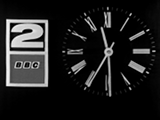 Despite all of this, and a slow start not helped by the channel’s early ‘Seven Faces’ schedule (each day was dedicated to a particular theme such as education on Tuesdays) which was unpopular and soon scrapped, BBC2 built up a loyal audience, courtesy of its quality programming which often catered for more specialist tastes.
Despite all of this, and a slow start not helped by the channel’s early ‘Seven Faces’ schedule (each day was dedicated to a particular theme such as education on Tuesdays) which was unpopular and soon scrapped, BBC2 built up a loyal audience, courtesy of its quality programming which often catered for more specialist tastes.
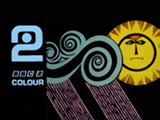 What also greatly helped BBC2 was that it was the first channel in the UK to start a colour service in 1967 as the intention was that colour should be available only on 625-line services, though colour programmes were few and far between to begin with and colour televisions were expensive. Having a second channel enabled the BBC to show (for example) more sporting action than was previously possible, as well as making room in the schedules on both channels for more imaginative programming. ITV was jealous.
What also greatly helped BBC2 was that it was the first channel in the UK to start a colour service in 1967 as the intention was that colour should be available only on 625-line services, though colour programmes were few and far between to begin with and colour televisions were expensive. Having a second channel enabled the BBC to show (for example) more sporting action than was previously possible, as well as making room in the schedules on both channels for more imaginative programming. ITV was jealous.
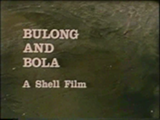 What were known as Trade Test Colour Films were first transmitted on BBC2 in 1964 during the weeks before the channel launched, then they were shown sporadically prior to a regular schedule commencing on 21 August 1967 ahead of the formal introduction of a colour service on BBC2. A wide variety of short colour films (usually less than 30 minutes in duration) were shown at various times of the day when no scheduled programmes were being broadcast, such as Atlantic Parks, Beauty In Trust, Coupe Des Alpes, L For Logic, Roads To Roam and Trans-Canada Journey, etc.; these films were obtained from various sources such as BP, British Transport, the National Film Board of Canada, Philips and Shell as well as the BBC themselves, and there was a regular trade test schedule right up until 24 August 1973, with the final film shown being Giuseppina.
What were known as Trade Test Colour Films were first transmitted on BBC2 in 1964 during the weeks before the channel launched, then they were shown sporadically prior to a regular schedule commencing on 21 August 1967 ahead of the formal introduction of a colour service on BBC2. A wide variety of short colour films (usually less than 30 minutes in duration) were shown at various times of the day when no scheduled programmes were being broadcast, such as Atlantic Parks, Beauty In Trust, Coupe Des Alpes, L For Logic, Roads To Roam and Trans-Canada Journey, etc.; these films were obtained from various sources such as BP, British Transport, the National Film Board of Canada, Philips and Shell as well as the BBC themselves, and there was a regular trade test schedule right up until 24 August 1973, with the final film shown being Giuseppina.
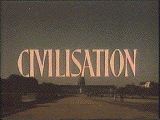 Top class documentaries such as Civilisation and The Ascent of Man helped give BBC2 (and the BBC in general) an enviable reputation that still exists to this day. Rightly or wrongly BBC2 initially had a reputation for being a ‘highbrow’ channel, and David Attenborough who was the channel’s controller from 1965-69 was broadly responsible for creating this upmarket image as an alternative to BBC1 and ITV.
Top class documentaries such as Civilisation and The Ascent of Man helped give BBC2 (and the BBC in general) an enviable reputation that still exists to this day. Rightly or wrongly BBC2 initially had a reputation for being a ‘highbrow’ channel, and David Attenborough who was the channel’s controller from 1965-69 was broadly responsible for creating this upmarket image as an alternative to BBC1 and ITV.
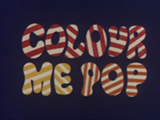 And it wasn’t just the documentaries that gave BBC2 a highbrow image; early music offerings included classical concerts and opera as well as jazz in the famous Jazz 625 series, but BBC2 also let its hair down with popular music: Colour Me Pop ran from 1968-9 as a spinoff from Late Night Line-Up and featured one artist per programme. Unfortunately very little survives of Colour Me Pop in the BBC’s archive unlike its spiritual successor The Old Grey Whistle Test, which began in 1972 and was presented by Bob Harris.
And it wasn’t just the documentaries that gave BBC2 a highbrow image; early music offerings included classical concerts and opera as well as jazz in the famous Jazz 625 series, but BBC2 also let its hair down with popular music: Colour Me Pop ran from 1968-9 as a spinoff from Late Night Line-Up and featured one artist per programme. Unfortunately very little survives of Colour Me Pop in the BBC’s archive unlike its spiritual successor The Old Grey Whistle Test, which began in 1972 and was presented by Bob Harris.
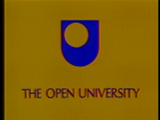 The Open University was introduced by Harold Wilson’s government in 1971, enabling adults to study for degree courses in their spare time as opposed to having to attend classroom lectures, with BBC2 being its outlet for course-related television programming. Despite being independent of the BBC, the Open University worked in close cooperation with the corporation and used Alexandra Palace as its base for many years. The OU shield logo occasionally rotated on-screen as its theme tune played (the first few bars of Divertimento by Leonard Salzedo) at the start of each block of programming, though the famous tune which some people thought was rather scary was dropped when BBC2 introduced its new presentation package in 1991.
The Open University was introduced by Harold Wilson’s government in 1971, enabling adults to study for degree courses in their spare time as opposed to having to attend classroom lectures, with BBC2 being its outlet for course-related television programming. Despite being independent of the BBC, the Open University worked in close cooperation with the corporation and used Alexandra Palace as its base for many years. The OU shield logo occasionally rotated on-screen as its theme tune played (the first few bars of Divertimento by Leonard Salzedo) at the start of each block of programming, though the famous tune which some people thought was rather scary was dropped when BBC2 introduced its new presentation package in 1991.
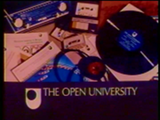 Several of the Open University’s early programmes were produced in black and white despite colour television having already been introduced, and OU course material also included self-study aids such as records and cassettes as well as textbooks, with video cassettes, CD/CD-ROM discs and DVD’s becoming available as technology progressed. Indeed the Open University no longer broadcasts course material via television channels because it no longer needs to.
Several of the Open University’s early programmes were produced in black and white despite colour television having already been introduced, and OU course material also included self-study aids such as records and cassettes as well as textbooks, with video cassettes, CD/CD-ROM discs and DVD’s becoming available as technology progressed. Indeed the Open University no longer broadcasts course material via television channels because it no longer needs to.

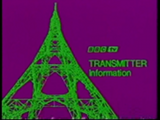
From 1967 until December 1982 there were regular transmitter information bulletins broadcast on BBC2, with three bulletins a day until 1975 when it was just one bulletin broadcast mid-morning (usually at 10.30). Each bulletin was usually three minutes long and comprised of any news relevant to the television trade such as information relating to the temporary disruption of broadcasts from specific transmitters, etc., and a list of colour trade test films to be broadcast that day (up until the films were no longer shown in August 1973). The accompanying theme music was entitled ‘Swirly’.
 With more people buying televisions capable of receiving UHF 625 line broadcasts during the 1970s even if they couldn’t watch them in colour, BBC2 was starting to pick up sizeable audiences for its programming as well as having the freedom to broadcast more specialised programmes catering for hobbies such as motoring (Wheelbase, later replaced by Top Gear, which then evolved into the entertainment show it has become today), gardening (Gardeners World – see the BBC Gardening section for more information), science (Horizon) and politics could now be covered in greater depth than ever before with programmes such as Newsnight.
With more people buying televisions capable of receiving UHF 625 line broadcasts during the 1970s even if they couldn’t watch them in colour, BBC2 was starting to pick up sizeable audiences for its programming as well as having the freedom to broadcast more specialised programmes catering for hobbies such as motoring (Wheelbase, later replaced by Top Gear, which then evolved into the entertainment show it has become today), gardening (Gardeners World – see the BBC Gardening section for more information), science (Horizon) and politics could now be covered in greater depth than ever before with programmes such as Newsnight.
 Call My Bluff was a popular genteel quiz game originally shown on BBC2 from 1965 to 1988, with Robert Robinson (pictured) being the show’s longest-serving presenter. Two teams comprising of three people (one regular team captain plus two celebrity guests) played against each other, with one team having to guess the correct definition of an obscure word shown on the rotating rectangular board purely based on three possible definitions read out in turn by the other team’s members; one of the definitions is true whilst the other two are just made-up nonsense. The word definitions are printed on cards, and when the captain of the team doing the guessing has chosen which person’s definition they think is correct, the card is then turned round to reveal either the word TRUE or BLUFF, with a correct guess scoring 1 point.
Call My Bluff was a popular genteel quiz game originally shown on BBC2 from 1965 to 1988, with Robert Robinson (pictured) being the show’s longest-serving presenter. Two teams comprising of three people (one regular team captain plus two celebrity guests) played against each other, with one team having to guess the correct definition of an obscure word shown on the rotating rectangular board purely based on three possible definitions read out in turn by the other team’s members; one of the definitions is true whilst the other two are just made-up nonsense. The word definitions are printed on cards, and when the captain of the team doing the guessing has chosen which person’s definition they think is correct, the card is then turned round to reveal either the word TRUE or BLUFF, with a correct guess scoring 1 point.
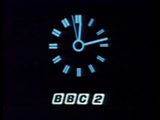 By 1980 BBC2 had developed comedy far beyond its original boundaries which were essentially derived from Victorian music hall productions. That Was the Week that Was (or TW3) had started the satirical trend on BBC1 (or BBC-tv as it was properly known at the time) in the 1960s, but BBC2 was free to develop ideas much further, being unhindered by the requirement to cater for a mass-market audience.
By 1980 BBC2 had developed comedy far beyond its original boundaries which were essentially derived from Victorian music hall productions. That Was the Week that Was (or TW3) had started the satirical trend on BBC1 (or BBC-tv as it was properly known at the time) in the 1960s, but BBC2 was free to develop ideas much further, being unhindered by the requirement to cater for a mass-market audience.
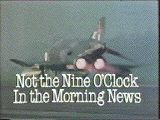 Not the Nine O’Clock News brought together Mel Smith, Griff Rhys Jones, Rowan Atkinson and Pamela Stephenson for the first time in this comedy sketch show with satirical leanings; it was so called because it was shown at 9pm opposite the Nine O’Clock News on BBC1 as a satirical alternative.
Not the Nine O’Clock News brought together Mel Smith, Griff Rhys Jones, Rowan Atkinson and Pamela Stephenson for the first time in this comedy sketch show with satirical leanings; it was so called because it was shown at 9pm opposite the Nine O’Clock News on BBC1 as a satirical alternative.
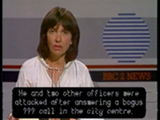 News bulletins were also shown on BBC2 for many years and they occasionally featured in-vision subtitles; this practice continued for a while even when the cost of televisions with teletext became easily affordable to those viewers who benefited from the provision of subtitles. Nowadays virtually all digital TV receivers have a subtitles facility, but certain programmes shown overnight on both BBC One and BBC Two also feature in-vision sign language for the hard-of-hearing.
News bulletins were also shown on BBC2 for many years and they occasionally featured in-vision subtitles; this practice continued for a while even when the cost of televisions with teletext became easily affordable to those viewers who benefited from the provision of subtitles. Nowadays virtually all digital TV receivers have a subtitles facility, but certain programmes shown overnight on both BBC One and BBC Two also feature in-vision sign language for the hard-of-hearing.
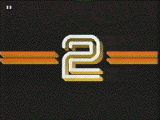 Despite the arrival of Channel 4 in 1982 which gave BBC2 direct competition for the first time, BBC2 continued to thrive throughout the 1980s by sticking to what it does best. Popular shows such as French and Saunders, Absolutely Fabulous and Blackadder started on BBC2 before moving to BBC1, and stars such as Rowan Atkinson and Victoria Wood started their TV careers on BBC2 shows. Schools programmes transferred from BBC1 to BBC2 in the Autumn Term of 1983, and a special “Daytime on 2” strand was created, featuring the BBC2 ident pictured but with a graduated orange background.
Despite the arrival of Channel 4 in 1982 which gave BBC2 direct competition for the first time, BBC2 continued to thrive throughout the 1980s by sticking to what it does best. Popular shows such as French and Saunders, Absolutely Fabulous and Blackadder started on BBC2 before moving to BBC1, and stars such as Rowan Atkinson and Victoria Wood started their TV careers on BBC2 shows. Schools programmes transferred from BBC1 to BBC2 in the Autumn Term of 1983, and a special “Daytime on 2” strand was created, featuring the BBC2 ident pictured but with a graduated orange background.
 March 1986 saw the introduction of a new look for BBC2, with a pastel-coloured TWO logo emerging from a white background used as the ident; the logo having been designed in-house as opposed to having been commissioned from an external design agency.
March 1986 saw the introduction of a new look for BBC2, with a pastel-coloured TWO logo emerging from a white background used as the ident; the logo having been designed in-house as opposed to having been commissioned from an external design agency.
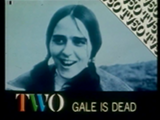 Also in 1986 there was the 50th anniversary of television to celebrate, and TV50 (as it was billed) featured several programmes to mark the occasion including The Fools On The Hill; a dramatisation of the early years of television at Alexandra Palace, mixing real people and events with fictional characters.
Also in 1986 there was the 50th anniversary of television to celebrate, and TV50 (as it was billed) featured several programmes to mark the occasion including The Fools On The Hill; a dramatisation of the early years of television at Alexandra Palace, mixing real people and events with fictional characters.
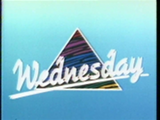 Play School was still being produced and shown on BBC2 right up to 1988, and in its last incarnation the title sequence animation made heavy use of ribbon-style coloured lines forming the house picture before revealing which day of the week it was, as was traditional for this long-running programme for young children.
Play School was still being produced and shown on BBC2 right up to 1988, and in its last incarnation the title sequence animation made heavy use of ribbon-style coloured lines forming the house picture before revealing which day of the week it was, as was traditional for this long-running programme for young children.
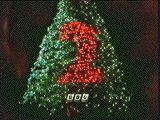 1991 saw the introduction of the famous short animations all featuring the number ‘2’ that formed the core of BBC2’s (then new) station identity, such as a ‘2’ symbol being splashed with paint (shown below) or a ‘2’ lit up with neon tubes. There were a host of special animations later introduced for various occasions; this is a still taken from a special ident used over the Christmas period in 1992.
1991 saw the introduction of the famous short animations all featuring the number ‘2’ that formed the core of BBC2’s (then new) station identity, such as a ‘2’ symbol being splashed with paint (shown below) or a ‘2’ lit up with neon tubes. There were a host of special animations later introduced for various occasions; this is a still taken from a special ident used over the Christmas period in 1992.
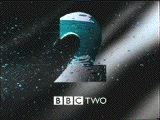 The BBC’s October 1997 corporate makeover resulted in the new-style BBC corporate logo and typeface (Gill Sans) being adopted. Both were developed by Martin Lambie-Nairn, who also developed (among numerous other projects) the Channel 4 logo. Some more new idents were introduced at the start of January 2000, and at this time www.bbc.co.uk was added to them.
The BBC’s October 1997 corporate makeover resulted in the new-style BBC corporate logo and typeface (Gill Sans) being adopted. Both were developed by Martin Lambie-Nairn, who also developed (among numerous other projects) the Channel 4 logo. Some more new idents were introduced at the start of January 2000, and at this time www.bbc.co.uk was added to them.
 BBC2 also has a reputation for being an educational channel; overnight it runs what is known as ‘The Learning Zone’ which used to features Open University programmes and the ‘Bite Size’ GCSE examination revision aid series. Note also in the top-left hand corner the use of a superimposed caption known in BBC-speak as a “DOG” (digitally originated graphic) which is used often during the Learning Zone period and frequently (at the time of writing) on the BBC’s digital only channels during programmes as a form of branding.
BBC2 also has a reputation for being an educational channel; overnight it runs what is known as ‘The Learning Zone’ which used to features Open University programmes and the ‘Bite Size’ GCSE examination revision aid series. Note also in the top-left hand corner the use of a superimposed caption known in BBC-speak as a “DOG” (digitally originated graphic) which is used often during the Learning Zone period and frequently (at the time of writing) on the BBC’s digital only channels during programmes as a form of branding.
 The test card used to be a very common sight on television screens, especially on BBC2 during the daytime (it wasn’t until 1988 that regular daytime programming was introduced on BBC2). Over the years, the test card was steadily replaced by other things such as Pages from Ceefax (used from 1980 until analogue TV transmissions were completely switched off in 2012) for the early morning gap between programmes and the Learning Zone, and later on the test card was subsequently confined to the BBC HD channel (combined with an audio test) until its closure in March 2012. Test Card F (shown here) was later superseded by the similar Test Card J and its widescreen companion Test Card W.
The test card used to be a very common sight on television screens, especially on BBC2 during the daytime (it wasn’t until 1988 that regular daytime programming was introduced on BBC2). Over the years, the test card was steadily replaced by other things such as Pages from Ceefax (used from 1980 until analogue TV transmissions were completely switched off in 2012) for the early morning gap between programmes and the Learning Zone, and later on the test card was subsequently confined to the BBC HD channel (combined with an audio test) until its closure in March 2012. Test Card F (shown here) was later superseded by the similar Test Card J and its widescreen companion Test Card W.
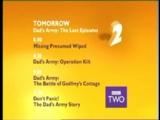 No matter how well liked something is, there comes a time when there is a requirement for something new to replace it. Following on from the very popular animations that characterised the channel was always going to be a tough job, so new character-orientated themes based on the ‘2’ symbol were introduced along with the BBC TWO text in a purple box to match the new corporate standard; not so much a revolution but evolution. A white ‘2’ symbol on a yellow backdrop does various things including bouncing around the screen or gains robotic arms to perform various tasks such as wiping a pane of glass. The (very rare) use of a clock was abandoned altogether at this point.
No matter how well liked something is, there comes a time when there is a requirement for something new to replace it. Following on from the very popular animations that characterised the channel was always going to be a tough job, so new character-orientated themes based on the ‘2’ symbol were introduced along with the BBC TWO text in a purple box to match the new corporate standard; not so much a revolution but evolution. A white ‘2’ symbol on a yellow backdrop does various things including bouncing around the screen or gains robotic arms to perform various tasks such as wiping a pane of glass. The (very rare) use of a clock was abandoned altogether at this point.
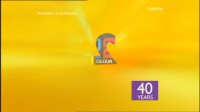 BBC2 celebrated its 40th birthday in 2004, and a special ident was created along with a celebratory programme entitled Happy Birthday BBC Two. Coincidentally, a 20 minute video recording of BBC2’s aborted first night was discovered earlier in the same year, giving an insight into exactly what happened that fateful evening when there was a power failure.
BBC2 celebrated its 40th birthday in 2004, and a special ident was created along with a celebratory programme entitled Happy Birthday BBC Two. Coincidentally, a 20 minute video recording of BBC2’s aborted first night was discovered earlier in the same year, giving an insight into exactly what happened that fateful evening when there was a power failure.
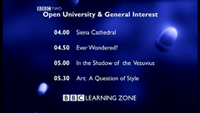 December 16 2006 saw another landmark event as it was the very last time television programmes related to Open University courses were broadcast overnight on BBC Two. Since the founding of the Open University in 1971 until 2006, television programmes were used as a primary visual medium for a wide range of self-study courses but various forms of new technology had essentially made traditional linear broadcast television programming somewhat redundant as a means of delivering course material, especially in relation to higher education degree courses. The Open University still produces television programmes for the BBC but they are aimed at a general audience as opposed to being course-related; examples of such productions include Bang Goes The Theory and Stargazing Live. All schools programmes moved to being shown overnight as part of The Learning Zone as of 2010.
December 16 2006 saw another landmark event as it was the very last time television programmes related to Open University courses were broadcast overnight on BBC Two. Since the founding of the Open University in 1971 until 2006, television programmes were used as a primary visual medium for a wide range of self-study courses but various forms of new technology had essentially made traditional linear broadcast television programming somewhat redundant as a means of delivering course material, especially in relation to higher education degree courses. The Open University still produces television programmes for the BBC but they are aimed at a general audience as opposed to being course-related; examples of such productions include Bang Goes The Theory and Stargazing Live. All schools programmes moved to being shown overnight as part of The Learning Zone as of 2010.
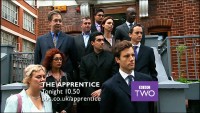 Modern BBC Two is generally still proving to be popular with audiences despite stiff competition from numerous other channels; new series such as The Apprentice and The Culture Show have proven to be popular with viewers, and Springwatch (a wildlife series presented by Bill Oddie) provided the surprise hit of 2005. However many of the popular US imports such as The Simpsons have now defected to other channels courtesy of commercial broadcasters who are now prepared to pay larger amounts of money for them, meaning that the teatime 6pm slot was proving to be rather troublesome (underlined by the failure of Dick and Dom’s Ask the Family ‘revival’) for the recently appointed (ex-BBC Four) controller Roly Keating.
Modern BBC Two is generally still proving to be popular with audiences despite stiff competition from numerous other channels; new series such as The Apprentice and The Culture Show have proven to be popular with viewers, and Springwatch (a wildlife series presented by Bill Oddie) provided the surprise hit of 2005. However many of the popular US imports such as The Simpsons have now defected to other channels courtesy of commercial broadcasters who are now prepared to pay larger amounts of money for them, meaning that the teatime 6pm slot was proving to be rather troublesome (underlined by the failure of Dick and Dom’s Ask the Family ‘revival’) for the recently appointed (ex-BBC Four) controller Roly Keating.
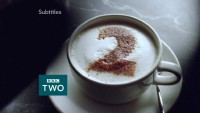 When the world begins to grow tired of bouncing 2’s and 2’s with robotic arms, etc., a new channel identity is perhaps inevitable. Step forward a new look BBC Two, which was refreshed on 18 February 2007 with what superficially looks very much like the sort of thing seen on BBC2 during the 1990s, namely the symbol ‘2’ featuring in a host of different situations such as the shape of a tent door or sprinklings on a cappuccino drink (pictured), though this cappuccino ident was soon to be dropped along with two other idents featuring a chase. However look closer and you can see other changes such as different colours being used for items such as logos and programme information captions.
When the world begins to grow tired of bouncing 2’s and 2’s with robotic arms, etc., a new channel identity is perhaps inevitable. Step forward a new look BBC Two, which was refreshed on 18 February 2007 with what superficially looks very much like the sort of thing seen on BBC2 during the 1990s, namely the symbol ‘2’ featuring in a host of different situations such as the shape of a tent door or sprinklings on a cappuccino drink (pictured), though this cappuccino ident was soon to be dropped along with two other idents featuring a chase. However look closer and you can see other changes such as different colours being used for items such as logos and programme information captions.
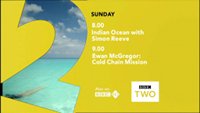 A large ‘cut-out’ 2 logo used in a similar style to Channel 4’s giant ‘4’ symbol was commonly used for promotions and idents during this period, though the overall effect might have been construed as a cheap copy of Channel 4’s award-winning identity. The BBC HD channel was frequently mentioned as well in programme promotions, because it simulcasted many BBC Two programmes in high definition (along with programmes from other BBC channels) from its launch in 2009 until March 2013 when the BBC HD channel became a dedicated BBC Two HD channel.
A large ‘cut-out’ 2 logo used in a similar style to Channel 4’s giant ‘4’ symbol was commonly used for promotions and idents during this period, though the overall effect might have been construed as a cheap copy of Channel 4’s award-winning identity. The BBC HD channel was frequently mentioned as well in programme promotions, because it simulcasted many BBC Two programmes in high definition (along with programmes from other BBC channels) from its launch in 2009 until March 2013 when the BBC HD channel became a dedicated BBC Two HD channel.
 In 2012, BBC Two featured a season of programmes devoted to the 1970s when it used mock 1970s-style presentation for both retro-themed and modern programming such as Sounds of the 70s and The Hairy Bikers’ Bakeation, with this ident being essentially identical to what BBC2 used during the early-1970s. There was also a series consisting of three hour-long programmes featuring archive footage entitled The 70s, presented by historian Dominic Sandbrook.
In 2012, BBC Two featured a season of programmes devoted to the 1970s when it used mock 1970s-style presentation for both retro-themed and modern programming such as Sounds of the 70s and The Hairy Bikers’ Bakeation, with this ident being essentially identical to what BBC2 used during the early-1970s. There was also a series consisting of three hour-long programmes featuring archive footage entitled The 70s, presented by historian Dominic Sandbrook.
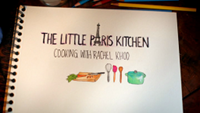 Very much typifying the modern BBC Two programme line-up are cookery programmes that set out to entertain as well as inform; for example, The Little Paris Kitchen, Great British Menu and The Great British Bake Off (amongst others) all aim to do exactly that. Plus continuing favourites like Coast, Top Gear and University Challenge coexist in the BBC Two schedule with new programmes for 2013 such as the fly-on-the-wall series The Railway and the surreal comedy It’s Kevin (starring Kevin Eldon).
Very much typifying the modern BBC Two programme line-up are cookery programmes that set out to entertain as well as inform; for example, The Little Paris Kitchen, Great British Menu and The Great British Bake Off (amongst others) all aim to do exactly that. Plus continuing favourites like Coast, Top Gear and University Challenge coexist in the BBC Two schedule with new programmes for 2013 such as the fly-on-the-wall series The Railway and the surreal comedy It’s Kevin (starring Kevin Eldon).
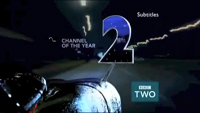 BBC Two HD launched on 26 March 2013 as a replacement for the BBC HD channel, simulcasting the existing standard definition BBC Two channel in HD or upscaled SD (as with the existing BBC One HD channel), and the BBC also used this occasion to also give BBC Two a minor presentational refresh; channel idents were given new soundtracks provided by current popular music artists such as alt-J, and new animations were also introduced to reinforce the channel brand. Also note the “Channel Of The Year” slogan due to BBC Two winning the award at the Edinburgh International Television Festival in 2012.
BBC Two HD launched on 26 March 2013 as a replacement for the BBC HD channel, simulcasting the existing standard definition BBC Two channel in HD or upscaled SD (as with the existing BBC One HD channel), and the BBC also used this occasion to also give BBC Two a minor presentational refresh; channel idents were given new soundtracks provided by current popular music artists such as alt-J, and new animations were also introduced to reinforce the channel brand. Also note the “Channel Of The Year” slogan due to BBC Two winning the award at the Edinburgh International Television Festival in 2012.